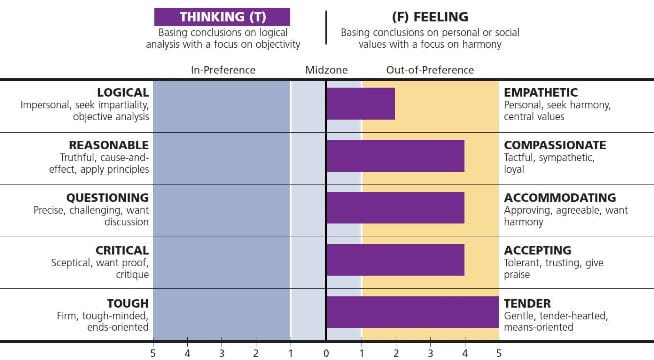I feel I have an MBTI preference for Thinking
Richard Stockhill MBTI Product Manager
As an MBTI Practitioner, we all work with people who struggle to reach a best-fit on one or another of the preference pairs. How often have you heard people object to being asked to make a choice, insisting ‘I do both!’? For some individuals this struggle can lead them to needlessly lose faith in the whole theory and framework. As we've talked about in a previous post, everyone does ‘do both’ in the same way that we use both hands, but still have a preference to work more with one than the other.
In this post I’ll share my own experience in getting to best-fit Type and the role of Step II in really understanding how the MBTI framework applies to me and my development.
Struggling with best-fit Type
Like most people, my journey to best-fit Type started with completing the MBTI Step I questionnaire. In the feedback discussion, I was clear on three of the four preferences: Introversion, Sensing and Judging. What was not clear was whether I had a preference for Thinking (T) or Feeling (F).
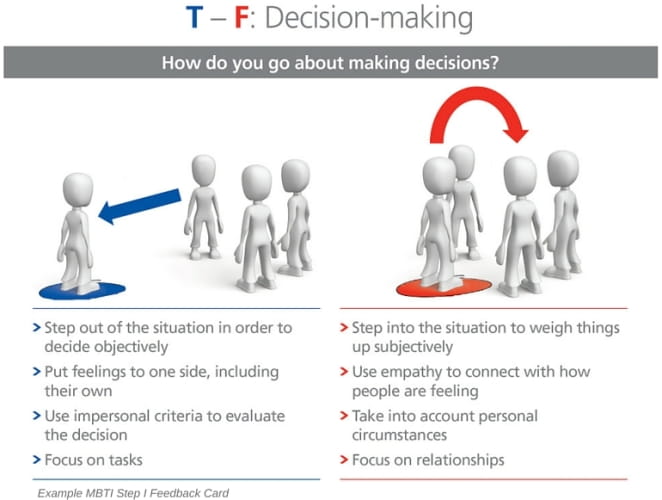
Even after keeping a diary of my decision making processes, I still couldn't get to a comfortable fit with this choice. I was clearly using both preferences and my diary supported this! I would weigh up facts but also consider the wider context and any possible impact on the people involved. I started to feel slightly disheartened as I was really hoping to gain insight from my best-fit Type that would help me.
The MBTI practitioner I was working with suggested I complete the Step II questionnaire. What I discovered deepened my understanding of myself and has supported my personal development ever since.
MBTI Step II breaks each of the four Step I preferences down into five facets of personality, 20 in total. It adds a depth of understanding to each preference that really helped me comprehend why I didn't feel I had a preference for either Thinking or Feeling. This was great.
So how did the Step II report help exactly?
In a typical Step II report (shown below) you’ll usually see a combination of:
- facets that are in preference (shown in the darker blue side of the image below)
- facets that are mid-zone (shown in the lighter blue mid-section of the image below)
- facets that are out of preference (shown in yellow side of the image below)
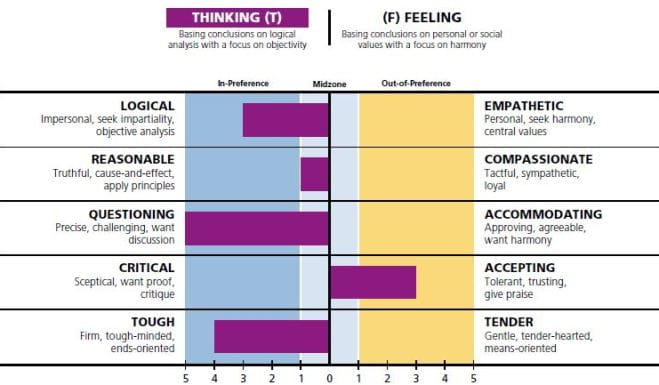
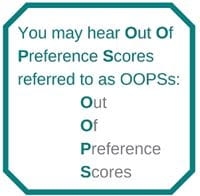 So you can see in this particular report, the individual has an overall preference for Thinking (‘Thinking’ highlighted in purple), where they exhibit in-preference scores on 3 out of the 5 facets, one score (Reasonable-Compassionate) in the Midzone, and one out-of-preference score (Accepting). If you met this person, you’d expect to see that, like most people with a Thinking preference, they are rather task-oriented and prefer to make decisions logically, asking lots of challenging questions in order to reach a conclusion, and once they have made a decision, they tend to stand firmly by it. In contrast to many Thinkers, in practice, this individual would also be expected to display some Reasonable-Compassionate balance in their actual decision-making, possibly as a result of having consciously learned to take on more of the compassionate perspective. You would also likely notice that if you provided them with an opposing viewpoint during their questioning phase, they would want to hear you out and to accommodate your perspective to create harmony – something more typically associated with a Feeling preference. For many people, understanding that they have a unique ‘fingerprint’ of behaviour relating to each preference unlocks deep understanding of how the MBTI framework applies to them.
So you can see in this particular report, the individual has an overall preference for Thinking (‘Thinking’ highlighted in purple), where they exhibit in-preference scores on 3 out of the 5 facets, one score (Reasonable-Compassionate) in the Midzone, and one out-of-preference score (Accepting). If you met this person, you’d expect to see that, like most people with a Thinking preference, they are rather task-oriented and prefer to make decisions logically, asking lots of challenging questions in order to reach a conclusion, and once they have made a decision, they tend to stand firmly by it. In contrast to many Thinkers, in practice, this individual would also be expected to display some Reasonable-Compassionate balance in their actual decision-making, possibly as a result of having consciously learned to take on more of the compassionate perspective. You would also likely notice that if you provided them with an opposing viewpoint during their questioning phase, they would want to hear you out and to accommodate your perspective to create harmony – something more typically associated with a Feeling preference. For many people, understanding that they have a unique ‘fingerprint’ of behaviour relating to each preference unlocks deep understanding of how the MBTI framework applies to them.
When my own Step II profile came back, my Step II profile for the Thinking/Feeling facets looked quite different from the typical profile. You’ll see below that I have a Step I preference for Thinking but all of my Step II facets reported as Out Of Preference – or on the Feeling side.
Many people, when they see a profile like mine assume that there must be some kind of mistake with the scoring. However, with the way Step II is score, this is perfectly possible, even though rather unusual.
So, at first I wondered how can I have a Step I preference for Thinking but behave in a way more typical of people with a Feeling preference? Surely my behaviour is driven by my underlying preference, right? Wrong.
What my Step II results highlighted was that my natural preference is different to my exhibited behaviour. I do have a preference for Thinking but life has shaped me to exhibit many Feeling behaviours.
Understanding this difference between natural preference and actual behaviour made perfect sense to me. Of course life impacts how you uniquely respond and behave.
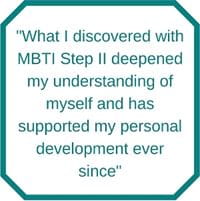 When working with my MBTI practitioner we focused on what may have created out-of-preference behaviours. There are many things that impact our exhibited behaviours such as careers (my own career started in the military), family values or other life-changing events.
When working with my MBTI practitioner we focused on what may have created out-of-preference behaviours. There are many things that impact our exhibited behaviours such as careers (my own career started in the military), family values or other life-changing events.
Breaking each preference into facets allows client and practitioner to discuss each in detail and really understand differences i.e. between natural preference and exhibited behaviours. This was a far more personal experience than I had with Step I. I hope this is food for thought if you are, or know someone struggling with finding their best-fit Type.
Because life shapes us all, it can sometimes be difficult to find a clear best-fit Type. You can feel like it just doesn't apply. I would challenge anyone to say the same thing after going through Step II feedback. Step II really changed how I felt about the MBTI framework.
If you've had a similar experience or want to share your own journey to best-fit Type, we’re always pleased to hear from you so leave a comment below.
More information
